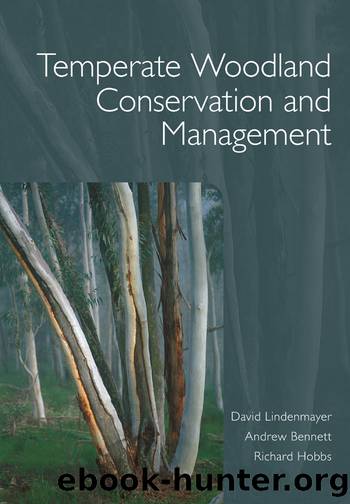Temperate Woodland Conservation and Management by Lindenmayer David;Bennett Andrew;Hobbs Richard;

Author:Lindenmayer, David;Bennett, Andrew;Hobbs, Richard;
Language: eng
Format: epub
Publisher: CSIRO Publishing
Conclusions
My strongest impression from working in Australiaâs woodlands is that a vast amount of biodiversity is currently being lost, and that large-scale emergency intervention is needed, particularly revegetation. Linear vegetation is valuable if carefully managed, but our research hints at the importance of large patches of habitat spaced at regular intervals across the landscape. Given the imperative to reconstruct habitat, there are two critical implications for public policy.
1. Have the triage debate. Should we regard conservation in remnant woodlands as a basket-case, or should society, or perhaps the industries that benefit from land clearing, fund the battle to halt species declines? Current funding of revegetation implies a basket-case decision in most agricultural regions, despite policy brochures proclaiming the opposite. The rate of biodiversity loss and likely ultimate extent of loss need to be widely understood, and weighed up against the cost of large-scale revegetation, and the possible benefits of alternative use of those funds.
2. If the policy decision is to fight to conserve woodland biodiversity, then investment in social, policy and ecological research becomes a priority so that land can be provided for revegetation, methods of revegetation are developed, and the human community is broadly supportive of biodiversity recovery.
In addition to developing revegetation methods, another important research goal is to link the characteristics of species with their response to habitat loss and fragmentation, and to fire. A stronger understanding of dispersal may be helpful, and is currently a major knowledge gap. If we can discover the mechanisms underlying speciesâ responses, it may be possible to predict the outcome of new scenarios, including revegetation and climate change scenarios. A capacity to compare scenarios will be an important tool in making management decisions because field-based revegetation experiments will take several decades to complete. Defining a range of best-bet actions using sound mechanistic models would provide a basis on which to implement large-scale and long-term revegetation experiments.
Download
This site does not store any files on its server. We only index and link to content provided by other sites. Please contact the content providers to delete copyright contents if any and email us, we'll remove relevant links or contents immediately.
Whiskies Galore by Ian Buxton(41561)
Introduction to Aircraft Design (Cambridge Aerospace Series) by John P. Fielding(32906)
Rewire Your Anxious Brain by Catherine M. Pittman(18337)
Craft Beer for the Homebrewer by Michael Agnew(17953)
Cat's cradle by Kurt Vonnegut(14804)
Sapiens: A Brief History of Humankind by Yuval Noah Harari(14006)
Leonardo da Vinci by Walter Isaacson(12834)
The Tidewater Tales by John Barth(12414)
Underground: A Human History of the Worlds Beneath Our Feet by Will Hunt(11857)
Thinking, Fast and Slow by Kahneman Daniel(11839)
The Radium Girls by Kate Moore(11652)
The Art of Thinking Clearly by Rolf Dobelli(9951)
A Journey Through Charms and Defence Against the Dark Arts (Harry Potter: A Journey Throughâ¦) by Pottermore Publishing(9147)
Mindhunter: Inside the FBI's Elite Serial Crime Unit by John E. Douglas & Mark Olshaker(8751)
Tools of Titans by Timothy Ferriss(7850)
Wonder by R. J. Palacio(7756)
Turbulence by E. J. Noyes(7733)
Change Your Questions, Change Your Life by Marilee Adams(7405)
Nudge - Improving Decisions about Health, Wealth, and Happiness by Thaler Sunstein(7273)
